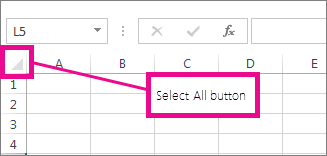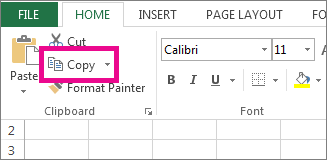Change the column width and row height
If you find yourself needing to expand or reduce Excel's row widths and column heights, there are several ways to adjust them. The table below shows the minimum, maximum and default sizes for each based on a point scale.
| Type | Min | Max | Default |
| Column | 0 (hidden) | 255 | 8.43 |
| Row | 0 (hidden) | 409 | 15.00 |
Notes:
-
If you are working in Page Layout view (View tab, Workbook Views group, Page Layout button), you can specify a column width or row height in inches, centimeters and millimeters. The measurement unit is in inches by default. Go to File > Options > Advanced > Display > select an option from the Ruler Units list. If you switch to Normal view, then column widths and row heights will be displayed in points.
-
Individual rows and columns can only have one setting. For example, a single column can have a 25 point width, but it can't be 25 points wide for one row, and 10 points for another.
Set a column to a specific width
-
Select the column or columns that you want to change.
-
On the Home tab, in the Cells group, click Format.

-
Under Cell Size, click Column Width.
-
In the Column width box, type the value that you want.
-
Click OK.
Tip: To quickly set the width of a single column, right-click the selected column, click Column Width, type the value that you want, and then click OK.
Change the column width to automatically fit the contents (AutoFit)
-
Select the column or columns that you want to change.
-
On the Home tab, in the Cells group, click Format.

-
Under Cell Size, click AutoFit Column Width.
Note: To quickly autofit all columns on the worksheet, click the Select All button, and then double-click any boundary between two column headings.

Match the column width to another column
-
Select a cell in the column that has the width that you want to use.
-
Press Ctrl+C, or on the Home tab, in the Clipboard group, click Copy.

-
Right-click a cell in the target column, point to Paste Special, and then click the Keep Source Columns Widths
 button.
button.
Change the default width for all columns on a worksheet or workbook
The value for the default column width indicates the average number of characters of the standard font that fit in a cell. You can specify a different number for the default column width for a worksheet or workbook.
-
Do one of the following:
-
To change the default column width for a worksheet, click its sheet tab.
-
To change the default column width for the entire workbook, right-click a sheet tab, and then click Select All Sheets on the shortcut menu.

-
-
On the Home tab, in the Cells group, click Format.

-
Under Cell Size, click Default Width.
-
In the Standard column width box, type a new measurement, and then click OK.
Tips:
-
If you want to define the default column width for all new workbooks and worksheets, you can create a workbook template or a worksheet template, and then base new workbooks or worksheets on those templates. See the following links for more information:
-
Change the width of columns by using the mouse
Do one of the following:
-
To change the width of one column, drag the boundary on the right side of the column heading until the column is the width that you want.

-
To change the width of multiple columns, select the columns that you want to change, and then drag a boundary to the right of a selected column heading.
-
To change the width of columns to fit the contents, select the column or columns that you want to change, and then double-click the boundary to the right of a selected column heading.
-
To change the width of all columns on the worksheet, click the Select All button, and then drag the boundary of any column heading.

Set a row to a specific height
-
Select the row or rows that you want to change.
-
On the Home tab, in the Cells group, click Format.

-
Under Cell Size, click Row Height.
-
In the Row height box, type the value that you want, and then click OK.
Change the row height to fit the contents
-
Select the row or rows that you want to change.
-
On the Home tab, in the Cells group, click Format.

-
Under Cell Size, click AutoFit Row Height.
Tip: To quickly autofit all rows on the worksheet, click the Select All button, and then double-click the boundary below one of the row headings.

Change the height of rows by using the mouse
Do one of the following:
-
To change the row height of one row, drag the boundary below the row heading until the row is the height that you want.

-
To change the row height of multiple rows, select the rows that you want to change, and then drag the boundary below one of the selected row headings.
-
To change the row height for all rows on the worksheet, click the Select All button, and then drag the boundary below any row heading.

-
To change the row height to fit the contents, double-click the boundary below the row heading.
If you prefer to work with column widths and row heights in inches, you should work in Page Layout view (View tab, Workbook Views group, Page Layout button). In Page Layout view, you can specify a column width or row height in inches. In this view, inches are the measurement unit by default, but you can change the measurement unit to centimeters or millimeters.
-
In Excel 2007, click the Microsoft Office Button
 > Excel Options> Advanced.
> Excel Options> Advanced. -
In Excel 2010, go to File > Options > Advanced.
Set a column to a specific width
-
Select the column or columns that you want to change.
-
On the Home tab, in the Cells group, click Format.

-
Under Cell Size, click Column Width.
-
In the Column width box, type the value that you want.
Change the column width to automatically fit the contents (auto fit)
-
Select the column or columns that you want to change.
-
On the Home tab, in the Cells group, click Format.

-
Under Cell Size, click AutoFit Column Width.
Tip To quickly autofit all columns on the worksheet, click the Select All button and then double-click any boundary between two column headings.

Match the column width to another column
-
Select a cell in the column that has the width that you want to use.
-
On the Home tab, in the Clipboard group, click Copy, and then select the target column.

-
On the Home tab, in the Clipboard group, click the arrow below Paste, and then click Paste Special.
-
Under Paste, select Column widths.
Change the default width for all columns on a worksheet or workbook
The value for the default column width indicates the average number of characters of the standard font that fit in a cell. You can specify a different number for the default column width for a worksheet or workbook.
-
Do one of the following:
-
To change the default column width for a worksheet, click its sheet tab.
-
To change the default column width for the entire workbook, right-click a sheet tab, and then click Select All Sheets on the shortcut menu.

-
-
On the Home tab, in the Cells group, click Format.

-
Under Cell Size, click Default Width.
-
In the Default column width box, type a new measurement.
Tip If you want to define the default column width for all new workbooks and worksheets, you can create a workbook template or a worksheet template, and then base new workbooks or worksheets on those templates. For more information, see Save a workbook or worksheet as a template.
Change the width of columns by using the mouse
Do one of the following:
-
To change the width of one column, drag the boundary on the right side of the column heading until the column is the width that you want.

-
To change the width of multiple columns, select the columns that you want to change, and then drag a boundary to the right of a selected column heading.
-
To change the width of columns to fit the contents, select the column or columns that you want to change, and then double-click the boundary to the right of a selected column heading.
-
To change the width of all columns on the worksheet, click the Select All button, and then drag the boundary of any column heading.

Set a row to a specific height
-
Select the row or rows that you want to change.
-
On the Home tab, in the Cells group, click Format.

-
Under Cell Size, click Row Height.
-
In the Row height box, type the value that you want.
Change the row height to fit the contents
-
Select the row or rows that you want to change.
-
On the Home tab, in the Cells group, click Format.

-
Under Cell Size, click AutoFit Row Height.
Tip To quickly autofit all rows on the worksheet, click the Select All button and then double-click the boundary below one of the row headings.

Change the height of rows by using the mouse
Do one of the following:
-
To change the row height of one row, drag the boundary below the row heading until the row is the height that you want.

-
To change the row height of multiple rows, select the rows that you want to change, and then drag the boundary below one of the selected row headings.
-
To change the row height for all rows on the worksheet, click the Select All button, and then drag the boundary below any row heading.

-
To change the row height to fit the contents, double-click the boundary below the row heading.
No comments:
Post a Comment